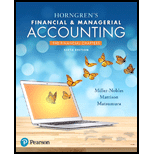
Horngren's Financial & Managerial Accounting, The Financial Chapters (6th Edition)
6th Edition
ISBN: 9780134486840
Author: Tracie L. Miller-Nobles, Brenda L. Mattison, Ella Mae Matsumura
Publisher: PEARSON
expand_more
expand_more
format_list_bulleted
Question
Chapter 8, Problem 20RQ
To determine
Note receivable:
Note receivable refers to a written promise for the amounts to be received within a stipulated period of time. This written promise is issued by a debtor or borrower to lender or creditor. Notes receivable is an asset of a business.
Interest on note receivable:
Interest on note receivable is the amount charged on the principal value of note for the privilege of borrowing money. Interest is to be paid by the borrower and to be received by the lender.
To show: The formula used to compute the interest on note receivable.
Expert Solution & Answer
Want to see the full answer?
Check out a sample textbook solution
Students have asked these similar questions
I am looking for the correct answer to this general accounting question with appropriate explanations.
I need help solving this general accounting question with the proper methodology.
Answer?
Chapter 8 Solutions
Horngren's Financial & Managerial Accounting, The Financial Chapters (6th Edition)
Ch. 8 - Prob. 1QCCh. 8 - Which of the following is a limitation of the...Ch. 8 - The entry to record a write-off of an...Ch. 8 - Brickman Corporation uses the allowance method to...Ch. 8 - Brickmans ending balance of Accounts Receivable is...Ch. 8 - 6. During the year, Bernard Company had net credit...Ch. 8 - At December 31 year-end, Crain Corporation has an...Ch. 8 - Using the data in the preceding question, what...Ch. 8 - At year-end, Schultz, Inc. has cash of 11,600,...Ch. 8 - Using the data in the preceding question, assume...
Ch. 8 - What is the difference between accounts receivable...Ch. 8 - Prob. 2RQCh. 8 - Prob. 3RQCh. 8 - When dealing with receivables, give an example of...Ch. 8 - What type of account must the sum of all...Ch. 8 - Prob. 6RQCh. 8 - What occurs when a business factors its...Ch. 8 - What occurs when a business pledges its...Ch. 8 - Prob. 9RQCh. 8 - Prob. 10RQCh. 8 - Prob. 11RQCh. 8 - Prob. 12RQCh. 8 - When using the allowance method, how are accounts...Ch. 8 - Prob. 14RQCh. 8 - Prob. 15RQCh. 8 - How does the percent- of-sales method compute bad...Ch. 8 - How do the percent-of-receivables and aging-of-...Ch. 8 - What is the difference between the...Ch. 8 - Prob. 19RQCh. 8 - Prob. 20RQCh. 8 - Prob. 21RQCh. 8 - Prob. 22RQCh. 8 - Prob. 23RQCh. 8 - Prob. 24RQCh. 8 - Prob. 8.1SECh. 8 - Prob. 8.3SECh. 8 - Prob. 8.4SECh. 8 - Prob. 8.5SECh. 8 - Prob. 8.6SECh. 8 - Prob. 8.7SECh. 8 - Prob. 8.8SECh. 8 - Prob. 8.9SECh. 8 - Prob. 8.10SECh. 8 - Prob. 8.11SECh. 8 - Prob. 8.12SECh. 8 - Prob. 8.13SECh. 8 - Defining common receivables terms Match the terms...Ch. 8 - Prob. 8.15ECh. 8 - Prob. 8.16ECh. 8 - Prob. 8.17ECh. 8 - E8-18 Accounting for uncollectible accounts using...Ch. 8 - E8-19 Accounting for uncollectible accounts using...Ch. 8 - E8-20 Accounting for uncollectible accounts using...Ch. 8 - E8-21 Journalizing transactions using the direct...Ch. 8 - Prob. 8.22ECh. 8 - Prob. 8.23ECh. 8 - Prob. 8.24ECh. 8 - Prob. 8.25ECh. 8 - Prob. 8.26ECh. 8 - Prob. 8.27ECh. 8 - P8-28A Accounting for uncollectible accounts using...Ch. 8 - Prob. 8.29APCh. 8 - Prob. 8.30APCh. 8 - Prob. 8.31APCh. 8 - P8-32A Accounting for notes receivable and...Ch. 8 - Prob. 8.33APCh. 8 - Prob. 8.34APCh. 8 - Prob. 8.35BPCh. 8 - Prob. 8.36BPCh. 8 - Prob. 8.37BPCh. 8 - Prob. 8.38BPCh. 8 - Prob. 8.39BPCh. 8 - P8-40B Accounting for notes receivable, dishonored...Ch. 8 - Prob. 8.41BPCh. 8 - Prob. 43CPCh. 8 - Prob. 44PSCh. 8 - Prob. 8.1TICh. 8 - Prob. 8.1DCCh. 8 - Decision Case 8-2
Pauline’s Pottery has always...Ch. 8 - Prob. 8.1FCCh. 8 - Use Target Corporation’s Fiscal 2015 Annual Report...
Knowledge Booster
Learn more about
Need a deep-dive on the concept behind this application? Look no further. Learn more about this topic, accounting and related others by exploring similar questions and additional content below.Similar questions
- I need help solving this general accounting question with the proper methodology.arrow_forwardCan you help me solve this general accounting problem using the correct accounting process?arrow_forwardPlease provide the accurate answer to this general accounting problem using valid techniques.arrow_forward
- hello teacher please give me correct answerarrow_forwardNova Inc. sets a standard of 6.5 hours per unit at $18 per hour. It produces 2,500 units, actually using 16,900 hours at a rate of $19 per hour. Find: (a) Labor rate variance (b) Labor time variance (c) Labor cost variancearrow_forwardcompute the standard direct material cost of a jewelry box??arrow_forward
arrow_back_ios
SEE MORE QUESTIONS
arrow_forward_ios
Recommended textbooks for you
- Principles of Accounting Volume 1AccountingISBN:9781947172685Author:OpenStaxPublisher:OpenStax College
 College Accounting, Chapters 1-27AccountingISBN:9781337794756Author:HEINTZ, James A.Publisher:Cengage Learning,
College Accounting, Chapters 1-27AccountingISBN:9781337794756Author:HEINTZ, James A.Publisher:Cengage Learning,

Principles of Accounting Volume 1
Accounting
ISBN:9781947172685
Author:OpenStax
Publisher:OpenStax College

College Accounting, Chapters 1-27
Accounting
ISBN:9781337794756
Author:HEINTZ, James A.
Publisher:Cengage Learning,
7.2 Ch 7: Notes Payable and Interest, Revenue recognition explained; Author: Accounting Prof - making it easy, The finance storyteller;https://www.youtube.com/watch?v=wMC3wCdPnRg;License: Standard YouTube License, CC-BY